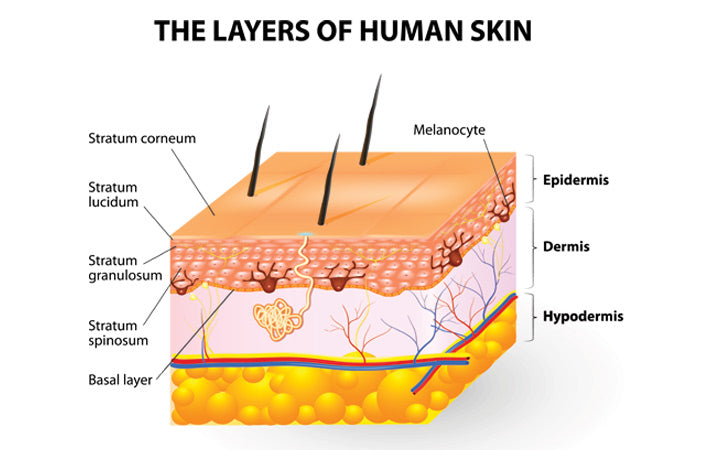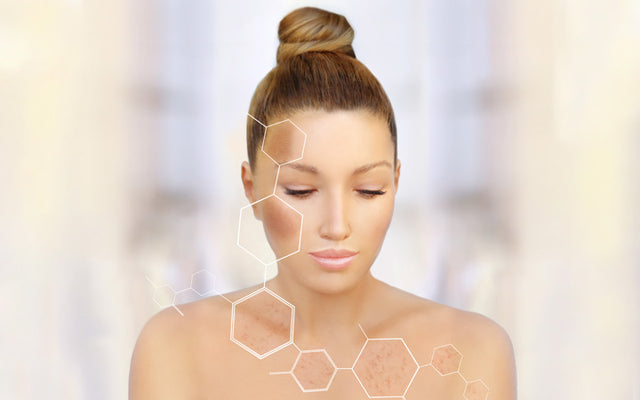Have you ever wondered what’s giving your skin its color or causing discoloration on some parts of your body? The root cause of it all is melanin, the brown to black pigment found in your skin, hair and iris of the eye that is responsible for your color/complexion.
Our chief dermatologist Dr. Harish Koutam, an accredited member of Indian Association of Dermatologists, Venereologists and Leprologists (IADVL) and Cosmetic Surgeons of India, affirms that melanin plays a dual role of protecting as well as causing harm in certain ways.
So whether you want to get tanned or lighten your tanned skin, you need to understand what melanin is and how you can increase or decrease its content. Scroll down to find out.
Highlights:
1. What Is Melanin And Why Is It Important?
Scientifically speaking, melanin is produced by melanocytes (cells) in the stratum basale (lowest layer) of the skin [1]. It happens when the enzyme tyrosinase catalyzes tyrosine to convert to dihydroxyphenylalanine (DOPA) [2].

According to scientific research, melanin can protect your skin from the harmful UV rays of the sun besides giving your skin its color. Recent studies also demonstrate the ability of melanin in decreasing the risk of skin cancer. [3]
Dr Harish says, “The shielding effect of melanin is achieved by its ability to serve as a physical barrier that scatters UVR and as an absorbent filter that reduces the penetration of UV through the epidermis (68). The efficacy of melanin as sunscreen was observed to be between 1.5 sun protective factors (SPF) and 4 SFP, implying that melanin absorbs 50% to 75% of UVR.”
He further adds, “It also functions as a free radical scavenger, which ultimately protects the skin. However, studies have found that melanin may have a weak carcinogenic effect that can contribute to cancer formation. But its deleterious effects have not been proved yet and research is on.”
2. Can I Decrease Melanin In My Skin?
Many Indian women are obsessed with fair skin color. Some people want to reduce melanin levels in their skin for a lighter shade of skin color. Melanin pigment can be reduced using at-home treatments, in-clinic procedures and home remedies.
In-Clinic Procedures
A. Chemical Peels
Chemical peels function by removing the top layer of the skin. [4] With this kind of exfoliation, the melanin deposits in the top layer is removed and a fresh layer of skin is exposed. Chemical peels include high concentrations of acids like glycolic acid or lactic acid. They are performed in a dermatologist’s office.
Chemical peels are an effective way to reduce melanin in your skin but they may pose side effects like redness and burning. Talk to your doctor before you begin the treatment. It is extremely important to use sunscreen while you are undergoing this treatment as the new cells are prone to sun damage.
B. Microdermabrasion
Microdermabrasion removes the top layer of the skin using a hand held device. It is a minimally invasive procedure to exfoliate the skin and get rid of excess melanin pigment. [5]
This procedure uses fine crystals to scrape or abrade the top layer of the skin. This is a low risk procedure and is effective at removing tan and making the skin smooth.
C. Laser Resurfacing
Laser resurfacing uses beams of light to target the skin layer. [6] It is further divided into ablative and non-ablative. Ablative lasers remove the top layers of the skin via wounding while non-ablative induce collagen growth in the epidermis.
The ablative laser may be slightly riskier when compared to non-ablative. Consult your dermatologist for the best possible laser treatment to reduce melanin in your skin.
At-Home Treatments
A. Kojic acid
Kojic acid is derived from certain kinds of fungi. It functions by inhibiting an amino acid, tyrosine that is responsible for producing melanin [7]. Kojic acid is a proven skin lightening agent and is used in concentrations of less than 1%.
Kojic acid may cause a side effect like contact dermatitis, a condition that leads to skin itching or redness, etc. after coming into contact with certain ingredients. Prolonged use of kojic acid can make your skin susceptible to sun damage.
B. Hydroquinone
Hydroquinone is one of the oldest and most effective treatments available to remove melanin from the skin. It decreases the number of melanocytes in the skin. [8]
Over time, hydroquinone lightens the skin. It’s natural alternative is mulberry. But hydroquinone may cause dryness in some people.
C. Retinoids
Retinoids are vitamin A derivatives that function by inhibiting the enzyme tyrosinase [9]. Tretinoin (a retinoid) is used to lighten the skin. Retinoids help in skin cell turnover and disperse the remaining melanin granules evenly on the skin.
The new cells produced are fresh and tender and require sunblock. So always use a broad spectrum sunscreen when using retinoids.
Home Remedies
People have been using kitchen ingredients to reduce melanin in the skin, but they do not have scientific evidence. However, they are benefiting people by lightening their skin.
A. Potato
Potato contains an enzyme called catecholase that decreases melanin levels in the skin. Potato is an excellent antioxidant helping the skin from oxidative stress.
B. Lemon
Lemon contains alpha hydroxy acid that exfoliates the top layer of the skin that contains melanin. Lemon is a natural bleaching agent.
C. Tomato
Tomato has many benefits for skin. One of them being its ability to inhibit the enzyme tyrosinase that helps in melanin synthesis. It has anti-inflammatory and anti-aging properties too.
3. What Causes Increased Melanin Production?
UV-A rays from the sunlight penetrate into the lower layers of the epidermis and trigger the melanocytes to produce more melanin. Melanin is produced as a defence mechanism.
Sunlight is the major cause of increased melanin production. Other factors include hormonal imbalances, aging and inflammation processes.
4. Can I Increase Melanin?
If you want to consider the fact that melanin can decrease the risk of skin cancer and protect you from UV rays, here are some ways to increase melanin in your skin:
How To Increase Melanin In Skin Permanently By Eating
There are no scientific studies that show how to increase melanin. But certain nutrients spike melanin levels in the skin:
A. Antioxidants
Antioxidants protect you from oxidative damage. The free radicals in your body are always looking for an extra electron and can chemically burn the cells during this process. Antioxidants have a free electron to donate, thereby stabilizing the wild free radicals.
Foods containing antioxidants include fish, grapes, berries, greens, green tea, beans, dark chocolate, beetroot, sweet potatoes, red cabbage etc.
B. Vitamin A
Since Vitamin A is also a powerful antioxidant, it is linked with increased melanin production. Vitamin A is a fat soluble vitamin found in the body.
Vitamin A can be obtained from food sources like green leafy vegetables, carrots, mangoes, peas, sweet potatoes, cod liver oil, salmon, tuna, butter, broccoli, lettuce, red bell peppers, cheese etc.
C. Vitamin C
Vitamin C, another antioxidant, is not proven to be beneficial for melanin production but may increase the levels of melanin.
Vitamin C is present in foods like plums, cherries, guavas, broccoli, sprouts, lemon, papaya, strawberries, orange, etc.
D. Vitamin E
You might have heard of vitamin E enriched skin care products a ton of times now. Vitamin E when applied topically soothes the skin.
Oral vitamin E is believed to increase the amount of melanin. Almonds, hazelnuts, peanuts, avocado, mango and lobster are all rich sources of vitamin E.
5. Does More Melanin Mean Darker Skin?
Based on melanin levels in the skin, skin complexions are broadly classified as light, medium and dark. Higher the melanin pigment, darker the skin.

6. What Happens When You Have Too Much Or Too Little Melanin?
Too little melanin can lead to a condition called albinism. People with albinism have pale skin and white hair. On the other hand, melanin deficiency can indicate hyperpigmentation.
7. Can Melanin Cause Skin Cancer?
UV radiation produces reactive oxygen that energises an electron in melanin. This energy can cause breaks in the DNA strands and can lead to carcinogenic mutations.
Researchers stressed on the role of melanin in skin cancer after exposing human melanocyte cells to UV lamp. They exposed mouse melanocytes and human melanocyte cells to UV lamps. They found DNA damage in both but continued damage in human melanocyte cells (containing melanin) even after hours of exposure to UV light. This brought them to a conclusion that melanin can cause skin cancer [10].
All the above methods are worth a try to increase or decrease melanin. But make sure you consult your dermatologist before starting any treatments or diet. Let us know what worked for you.
1. https://pubchem.ncbi.nlm.nih.gov/compound/Melanin
2. https://www.ncbi.nlm.nih.gov/pmc/articles/PMC3242935/
3. https://www.ncbi.nlm.nih.gov/pmc/articles/PMC2671032/
4. https://medlineplus.gov/skinpigmentationdisorders.html
5. https://medlineplus.gov/skinpigmentationdisorders.html
6. https://medlineplus.gov/skinpigmentationdisorders.html
7. https://www.ncbi.nlm.nih.gov/pmc/articles/PMC3468271/
8. https://www.ncbi.nlm.nih.gov/books/NBK539693/
Recommended Products
Was this Article helpful?
- Least helpful
- Most helpful











